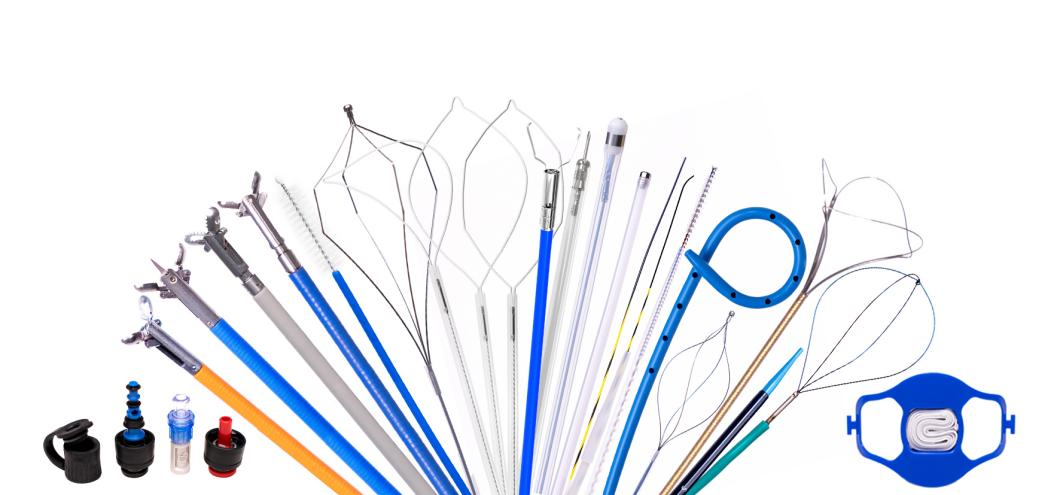Esophageal/gastric varices are the result of the persistent effects of portal hypertension and are approximately 95% caused by cirrhosis of various causes. Varicose vein bleeding often involves large amounts of bleeding and high mortality, and patients with bleeding have little tolerance for surgery.
With the improvement and application of digestive endoscopic treatment technology, endoscopic treatment has become one of the main ways to treat esophageal/gastric variceal bleeding. It mainly includes endoscopic sclerotherapy (EVS), endoscopic variceal ligation (EVL) and endoscopic tissue glue injection therapy (EVHT).
Endoscopic Sclerotherapy (EVS)
part 1
1) Principle of endoscopic sclerotherapy (EVS):
Intravascular injection: sclerosing agent causes inflammation around the veins, hardens the blood vessels and blocks blood flow;
Paravascular injection: causing a sterile inflammatory reaction in the veins to cause thrombosis.
2) Indications of EVS:
(1) Acute EV rupture and bleeding;
(2) Previous history of EV rupture and bleeding;
(3) Patients with recurrence of EV after surgery;
(4) Those who are not suitable for surgical treatment.
3)Contraindications of EVS:
(1) Same contraindications as gastroscopy;
(2) Hepatic encephalopathy stage 2 or above;
(3) Patients with severe liver and kidney dysfunction, large amounts of ascites, and severe jaundice.
4) Operation precautions
In China, you can choose lauromacrol(Use sclerotherapy needle). For larger blood vessels, choose intravascular injection. The injection volume is generally 10 to 15 mL. For smaller blood vessels, you can choose paravascular injection. Try to avoid injecting at several different points on the same plane ( Ulcers may occur leading to esophageal stricture). If breathing is affected during the operation, a transparent cap can be added to the gastroscope. In foreign countries, a balloon is often added to the gastroscope. It is worth learning from.
5) Postoperative treatment of EVS
(1) Do not eat or drink for 8 hours after surgery, and gradually resume liquid food;
(2) Use appropriate amounts of antibiotics to prevent infection;
(3) Use drugs to lower portal pressure as appropriate.
6) EVS treatment course
Multiple sclerotherapy is required until the varicose veins disappear or basically disappear, with an interval of about 1 week between each treatment; gastroscopy will be reviewed 1 month, 3 months, 6 months, and 1 year after the end of the course of treatment.
7) Complications of EVS
(1) Common complications: ectopic embolism, esophageal ulcer, etc., and it is easy to cause blood spurting or gushing blood from the needle hole when removing the needle.
(2) Local complications: ulcers, bleeding, stenosis, esophageal motility dysfunction, odynophagia, lacerations. Regional complications include mediastinitis, perforation, pleural effusion, and portal hypertensive gastropathy with an increased risk of bleeding.
(3) Systemic complications: sepsis, aspiration pneumonia, hypoxia, spontaneous bacterial peritonitis, portal vein thrombosis.
Endoscopic varicose vein ligation (EVL)
Part 2
1) Indications for EVL: Same as EVS.
2)Contraindications of EVL:
(1) Same contraindications as gastroscopy;
(2) EV accompanied by obvious GV;
(3) Patients with severe liver and kidney dysfunction, large amounts of ascites, jaundice, recent multiple sclerotherapy treatments or small varicose veins.
3)How to operate
Including single hair ligation, multiple hair ligation, and nylon rope ligation.
(1) Principle: Block the blood flow of varicose veins and provide emergency hemostasis → venous thrombosis at the ligation site → tissue necrosis → fibrosis → disappearance of varicose veins.
(2) Precautions
For moderate to severe esophageal varices, each varicose vein is ligated in a spiral upward manner from bottom to top. The ligator should be as close as possible to the target ligation point of the varicose vein, so that each point is fully ligated and densely ligated. Try to cover each varicose vein at more than 3 points.
It takes about 1 to 2 weeks for the necrosis to fall off after bandage necrosis. One week after the operation, local ulcers may cause massive bleeding, the skin band falls off, and mechanical cutting of varicose veins bleeds. EVL can eradicate varicose veins quickly and has few complications, but varicose veins recur. The proportion is on the high side;
EVL can block the bleeding collaterals of the left gastric vein, esophageal vein, and vena cava. However, after esophageal venous blood flow is blocked, the gastric coronary vein and perigastric venous plexus will expand, the blood flow will increase, and the recurrence rate will increase over time. Therefore, it is often Repeated band ligation is required to consolidate the treatment. The diameter of varicose vein ligation should be less than 1.5 cm.
4) Complications of EVL
(1) Massive bleeding due to local ulcers about 1 week after surgery;
(2) Intraoperative bleeding, loss of leather band, and bleeding caused by varicose veins;
(3) Infection.
5) Postoperative review of EVL
In the first year after EVL surgery, liver and kidney function, B-ultrasound, blood routine, coagulation function, etc. should be reviewed every 3 to 6 months. Endoscopy should be reviewed every 3 months, and then every 0 to 12 months.
6)EVS vs EVL
Compared with sclerotherapy and ligation, there is no significant difference in mortality and rebleeding rates between the two. For patients who need repeated treatments, ligation is more commonly recommended. Sometimes ligation and sclerotherapy are also combined, which can improve treatment. Effect. In foreign countries, fully covered metal stents are also used to stop bleeding.
Endoscopic tissue glue injection therapy (EVHT)
part 3
This method is suitable for gastric varices and esophageal variceal bleeding in emergency situations.
1) Complications of EVHT: mainly pulmonary artery and portal vein embolism, but the incidence is very low.
2) Advantages of EVHT: varicose veins disappear quickly, re-bleeding rate is low, complications are relatively few, indications are wide and the technology is easy to master.
3) Things to note:
In endoscopic tissue glue injection therapy, the amount of injection must be sufficient. Endoscopic ultrasound plays a very good role in the treatment of varicose veins and can reduce the risk of re-bleeding.
There are reports in foreign literature that the treatment of gastric varices with coils or cyanoacrylate under the guidance of endoscopic ultrasound is effective for local gastric varices. Compared with cyanoacrylate injections, endoscopic ultrasound-guided coiling requires fewer intraluminal injections and is associated with fewer adverse events.
We, Jiangxi Zhuoruihua Medical Instrument Co.,Ltd., is a manufacturer in China specializing in the endoscopic consumables, such as biopsy forceps, hemoclip, polyp snare, sclerotherapy needle, spray catheter, cytology brushes, guidewire, stone retrieval basket, nasal biliary drainage catheter etc. which are widely used in EMR, ESD, ERCP. Our products are CE certified, and our plants are ISO certified. Our goods have been exported to Europe, North America, Middle East and part of Asia, and widely obtains the customer of the recognition and praise!

Post time: Aug-15-2024


